AMD Socket-AM2: Same Performance, Faster Memory, Lower Power
by Anand Lal Shimpi on May 23, 2006 12:14 PM EST- Posted in
- CPUs
Athlon 64 X2 5000+: A Cheap FX or Overpriced 4800+?
Although the FX-62 conclusion was pretty straight forward, the Athlon 64 X2 5000+ gives us another ambiguous candidate to evaluate. Clocked at 2.6GHz, the 5000+ gives you a nice clock speed advantage over previous X2s. However, with only a 512KB L2 cache there may be situations where the clock speed advantage over the Athlon 64 X2 4800+ is diminished.
3D Rendering - Cinebench 9.5
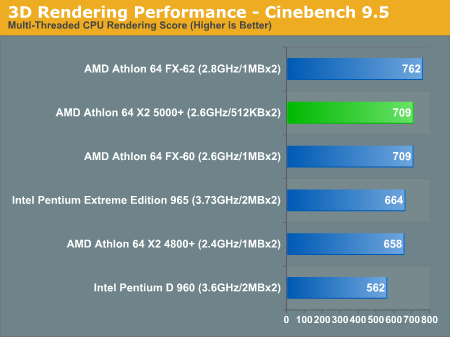
We've already seen that many of our 3D rendering and media encoding tests are cache-size independent when running on Athlon 64 X2/FX processors, thus it's no surprise that the X2 5000+ is able to offer identical performance to the FX-60 despite having half the L2 cache per core. The clock speed advantage over the X2 4800+ is also significant enough to offer a pretty decent performance advantage; in fact, in this light, the Athlon 64 X2 5000+ looks pretty impressive.
3D Rendering - 3dsmax 7
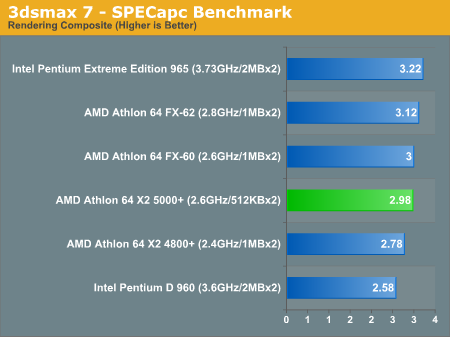
The story under 3dsmax 7 is pretty similar to what we saw under Cinebench; there is a slight performance penalty compared to the FX-60 thanks to a smaller L2 cache, but overall the performance of the X2 5000+ is quite respectable. As we saw in our FX-62 investigation from the previous page, the Extreme Edition 965 is very tough to beat in this test thanks to its high clock speed, very fast FSB and dual core + Hyper Threading combination.
Video Encoding - DivX 6.1.1 Pro
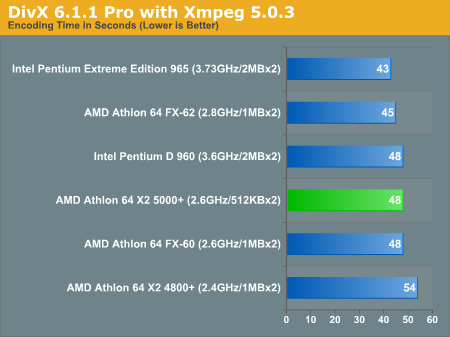
Once again, there's no performance difference between the X2 5000+ and the FX-60, bringing the 5000+ very close in performance to the FX-62 at a significantly lower cost. Thanks to the clock speed advantage, the 5000+ is also clearly faster than the X2 4800+.
Video Encoding - Windows Media Encoder 9
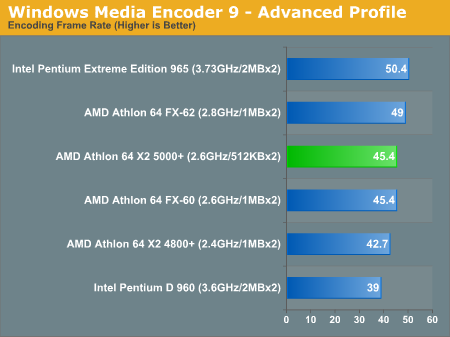
Windows Media Encoder 9 also has the X2 5000+ and FX-60 performing identically, and obviously outperforming the X2 4800+.
Video Encoding - Quicktime 7.0.4 (H.264)
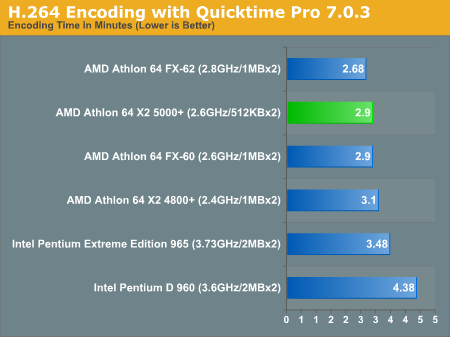
The video encoding trend continues with our Quicktime H.264 test, the 5000+ is second only to the FX-62.
MP3 Encoding - iTunes 6.0.1.4
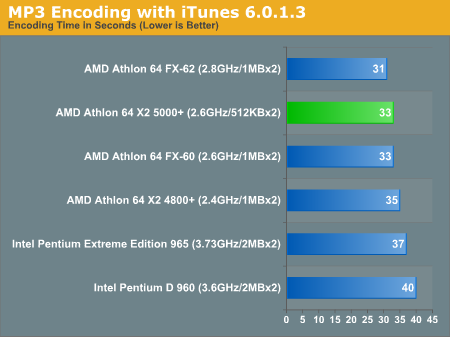
Our iTunes MP3 encoding test produces identical results to what we've already seen in previous benchmarks, the Athlon 64 X2 5000+ isn't really hampered by its 512KB L2 cache thus far.
Gaming - Quake 4
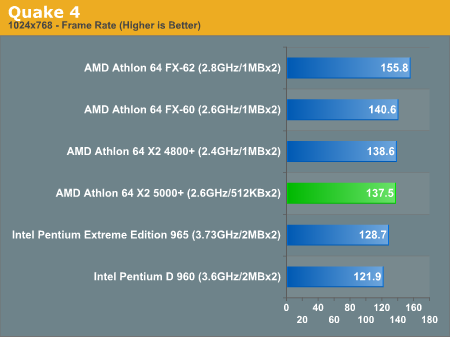
The tables do turn as we look at gaming performance however; not only does the Athlon 64 X2 5000+ lose to the FX-60, but it also loses to the lower clocked Athlon 64 X2 4800+. While the Athlon 64 X2 5000+ is wonderful in our application tests, it looks like there may be a very different verdict for gamers.
Gaming - F.E.A.R.

Under F.E.A.R. the FX-60 is faster than the X2 5000+ once again, but this time the best the X2 4800+ can manage is to tie the performance of the 5000+. Given the $51 price premium for the 5000+, we'd want something that was at least faster than the 4800+.
Gaming - Oblivion
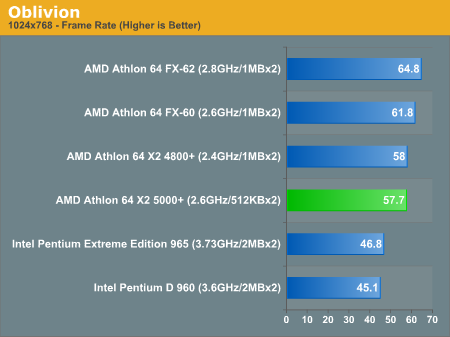
Finally in Oblivion we see that the X2 4800+ is ever so slightly faster than the 5000+, once again thanks to its larger L2 cache (despite a lower core clock speed).
The Athlon 64 X2 5000+ Conclusion
Once again we see the problem with AMD's model number system, where in some cases the 5000+ is no different than a FX-60 and in others it is only as fast if not slower than the cheaper X2 4800+. Our recommendation here would be to only opt for the 5000+ if you aren't a gamer, as it seems that 3D games are far more likely to appreciate a larger L2 cache than a higher clock speed with these chips.










83 Comments
View All Comments
Griswold - Tuesday, May 23, 2006 - link
Sounds conceiveable indeed. Though, the latter option would probably blow TDP out of proportion on 90nm.
mlittl3 - Tuesday, May 23, 2006 - link
Yeah, that is a problem but Anand did say "trick up its sleeve" so maybe they have one last 90 nm manufacturing process that's better than today's. I've read some articles about L3 cache coming for AMD and one inquirer.net article (take with grain of salt) that says AMD will ramp clock speeds fast. Maybe the trick will have something to do with these factors. Who knows?darkdemyze - Tuesday, May 23, 2006 - link
Whatever it is I'm interested in reading about itRegs - Tuesday, May 23, 2006 - link
Whatever it is, it's going to be expensive.TrogdorJW - Tuesday, May 23, 2006 - link
Actually, I was sort of thinking that the "stopgap solution" might be to cut prices. God only knows that I would love to see a $200 X2 processor!Griswold - Tuesday, May 23, 2006 - link
Well, they will have to drop prices at some point after core 2 is actually available.xFlankerx - Tuesday, May 23, 2006 - link
Indeed, same results as expected. Maybe this will make the AMD fanboys shut up about "waiting to see what the final results are." NOTE: I have a AMD system, I'm simply addressing those that refuse to accept Conroe's superiority.Although...I must say that this "stop gap" solution by AMD has piqued my curiosity.
But I believe that these say it perfectly;
"One of its stipulations for sending out Socket-AM2 review kits was that the CPUs not be compared to Conroe."
"We do get a sense of concern whenever Conroe is brought up around AMD."
"So when Intel first started talking about its new Core architecture, we turned to AMD for a response that it surely must have had in the works for years, but as you all know we came up empty handed."
Those just say it all for me. Seems like AMD's in trouble. From what I've been reading, K8L doesn't bring in architectural changes either. Sure you get Quad Cores, L3 cache, FB-DIMM support, DDR3, and faster HyperTransport, but if AMD doesn't improve on it's performance-per-clock efficiency, then Intel's Quad Cores (due almost 9 months before AMD's) are going to rule supreme yet again.
Griswold - Tuesday, May 23, 2006 - link
Maybe read up on it first.
Memory mirroring, data poisoning, HT retry protocol support, doubled prefetch size (32byte instead of 16), 2x 128bit SSE units (instead of 2x 64bit), out of order load execution, Indirect branch predictors and a handful new instructions sure sounds like a few architectural changes and not just a simple revision stepping.
rADo2 - Tuesday, May 23, 2006 - link
Sorry, links again:Intel Conroe @ 3.9GHz: SuperPI 1M - 12.984s
http://www.xtremesystems.org/forums/showthread.php...">http://www.xtremesystems.org/forums/showthread.php...
AMD FX-57 @ 4.2GHz: SuperPI 1M - 21.992s
http://www.xtremesystems.org/forums/showthread.php...">http://www.xtremesystems.org/forums/showthread.php...
MadAd - Monday, May 29, 2006 - link
Try measuring like for like and then come back with your silly benchmark comparison. EG use a superpi data size that will fit on BOTH cpus caches, not just conroes and then compare performance.With the FX57 having just a 1M cache its bullsht smoke and mirrors saying the 1M superpi is slower, o rly? perhaps thats because it takes more than 1M to hold both the feature and data sets on a 1M superpi.
muppet